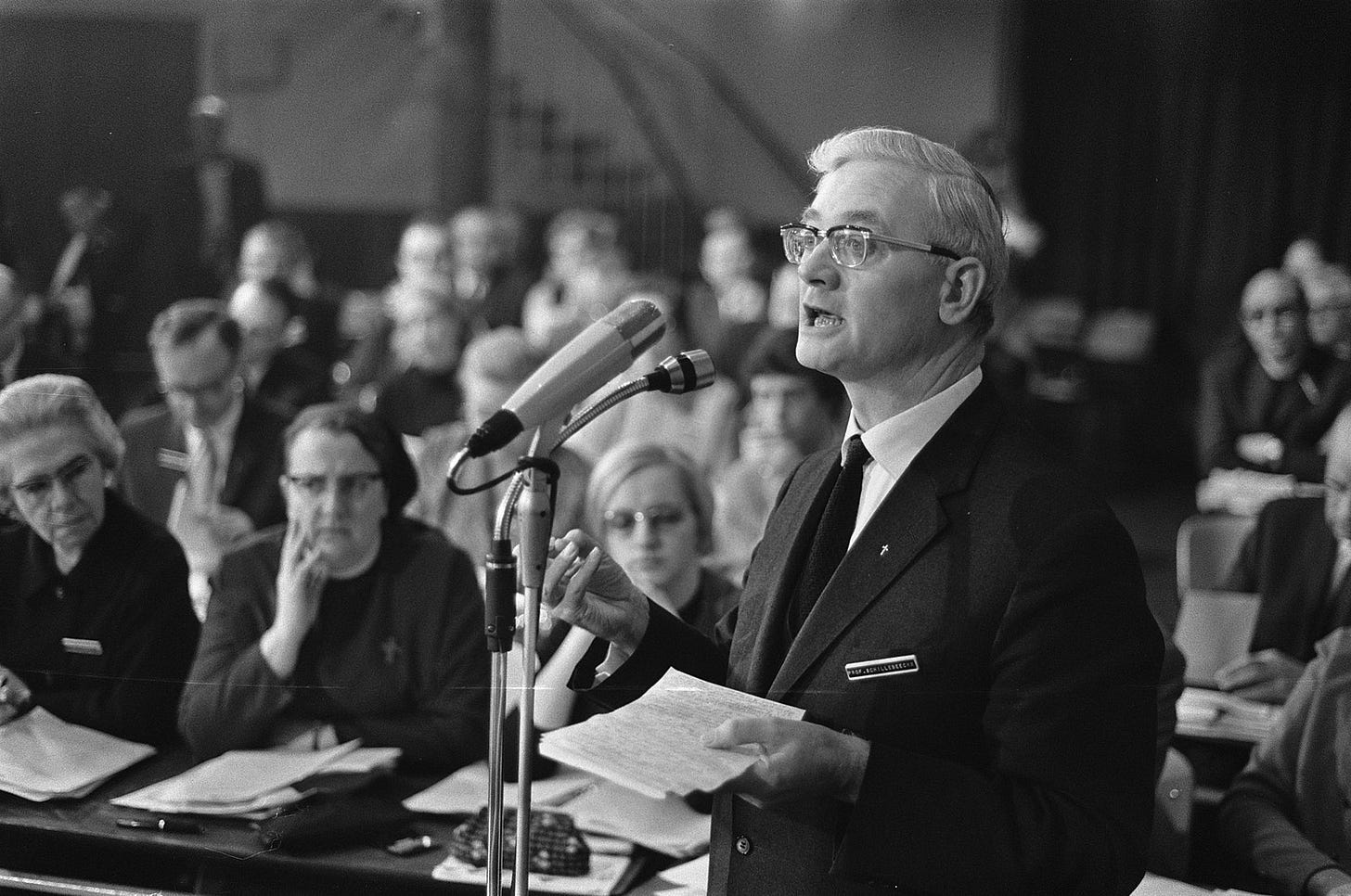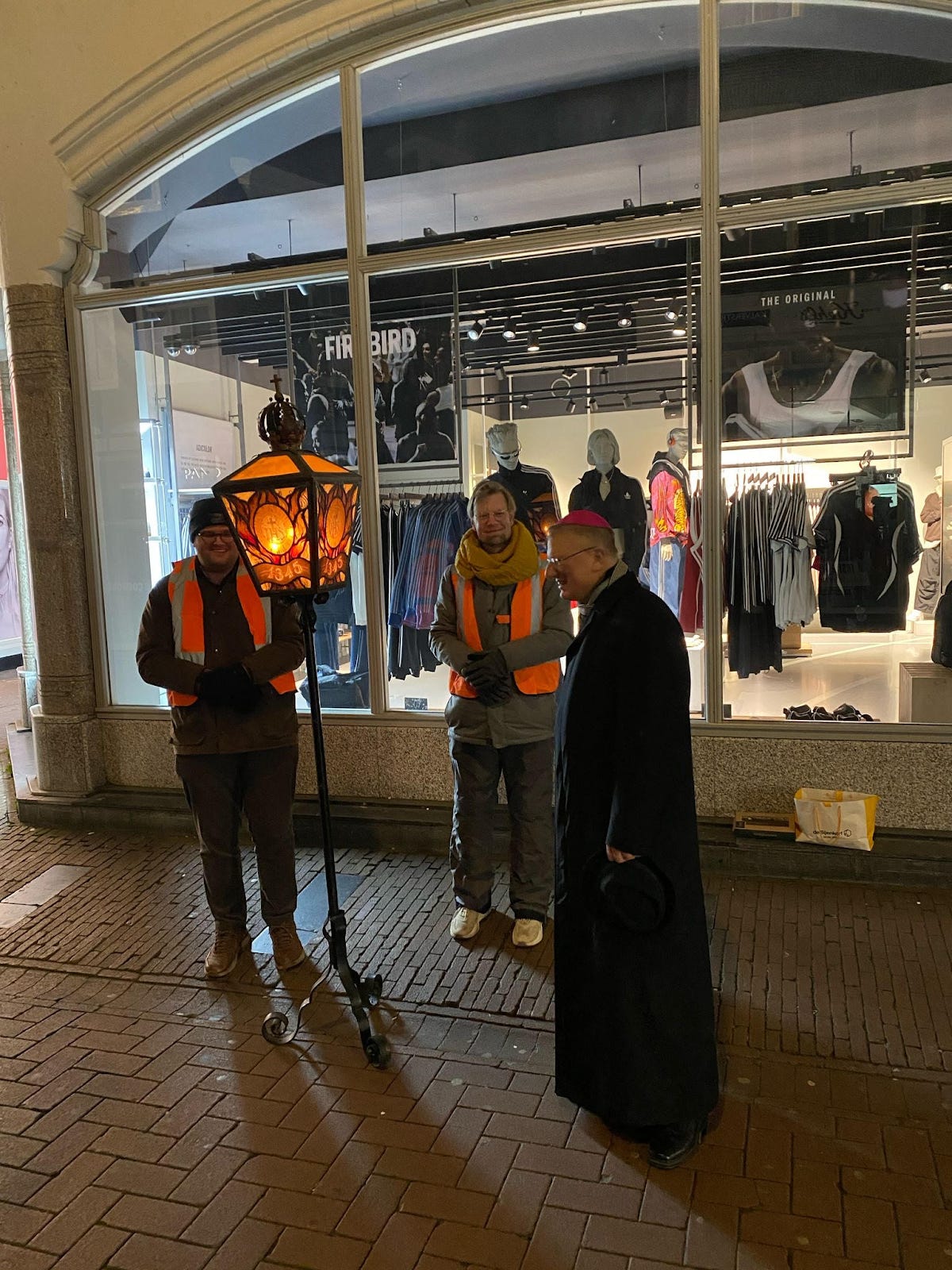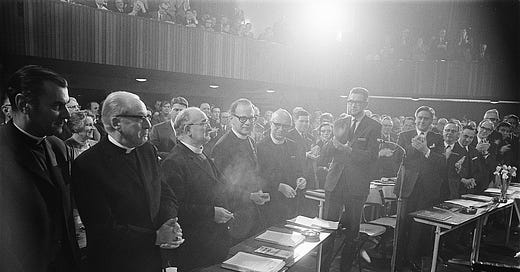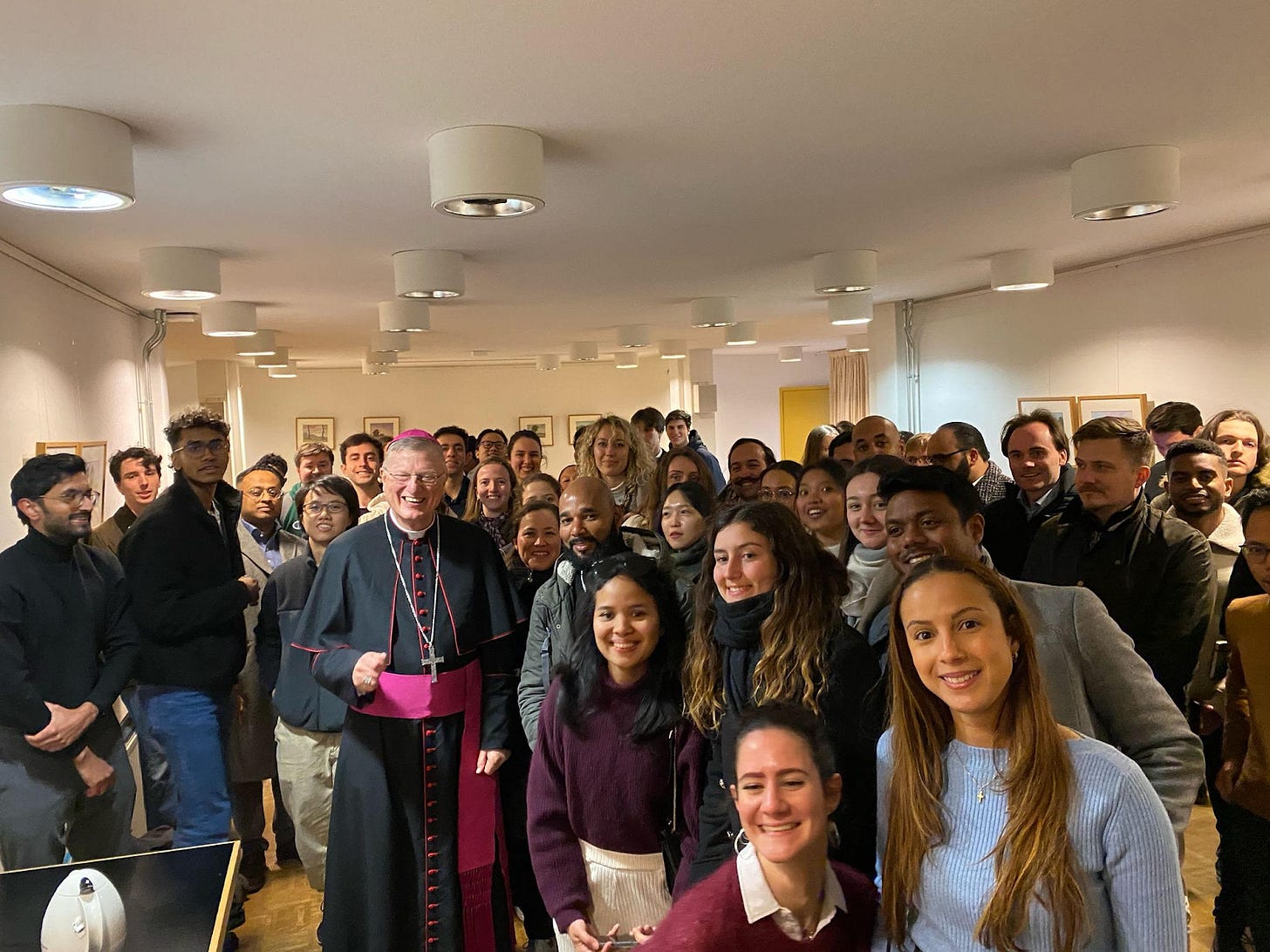
‘Vatican II was used as a departure, not a foundation’
Bishop Hendriks of Amsterdam remembers the Netherlands’ post-conciliar period
In the years following the Second Vatican Council, the Netherlands experienced more upheaval than just about any country in the world, at least as some historians view it.
The country’s bishops relinquished oversight of Catholic education, shut down all seminaries, and agreed to take part in a controversial national “pastoral council,” a body meant to consider and help implement Vatican Council II, but which proposed sweeping changes to priestly celibacy, Catholic sexual ethics, and the liturgy.
A process of secularization already underway in Dutch society shifted into overdrive.
The Netherlands went from providing 10% of the Catholic missionaries in the world and having a Sunday Mass attendance of over 90% at the beginning of the 1950s, to being one of the least religious countries in the world, especially in its traditionally Catholic regions.
Vocations plummeted, dioceses have sold or consolidated a significant portion of their parishes at a staggering pace, and Sunday Mass attendance among Catholics is below 1% in some dioceses and hovers around 2% nationwide.
In the decades after, Dutch Catholicism became synonymous with “experimental” theology, and for many it carried the whiff of liturgical abuses and even heterodoxy.
To some observers, Vatican Council II was the start of the decline and the root of the problems facing the Church in the Netherlands. But not everyone blames Vatican II for the crisis of Dutch Catholicism.
Bishop Jan Hendriks of Haarlem-Amsterdam studied at the Leeuwenhorst minor seminary where the Pastoral Council was held from 1966 to 1970, giving him a front row seat to the reception of Vatican Council II in his country.
He would go on to serve as a priest in the diocese of Rotterdam during the troubling post-conciliar times in the Netherlands. He became an auxiliary bishop of Haarlem-Amsterdam in 2011 and the bishop of the same diocese in 2020.
In his view, Hendriks said, the issue wasn’t the council — it was a desire on the part of a small cadre of Church leaders to push beyond Vatican II for changes they’d hoped to see in the Church.
Marking the 60th anniversary of the end of the Second Vatican Council, The Pillar talked with Hendriks about the national Pastoral Council, the crisis of Dutch Catholicism, and what a true reception of Vatican II might look like in the Netherlands today.
The interview has been edited for clarity and length.
You were a minor seminarian during the Dutch “pastoral council” and attended some of the sessions.
What was the “pastoral council?”
The so-called Dutch Pastoral Council was an initiative of the Pastoral Institute of the Dutch Church Province, where Father Walter Goddijn was in charge.
The original idea was to receive the Second Vatican Council but also to go further in applying it to the Dutch situation.
Following the “spirit” of the Council…?
Yes, the idea behind it was to develop Vatican II by going beyond it.
Professor Edward Schillebeeckx, who was the advisor of the Dutch bishops in the Second Vatican Council, was a bit disappointed about the result of the [Vatican] council. He said at the time that it didn’t go all the way, that it was a “compromise” council… I suppose he felt this way because the [Vatican II] did not accept most of his ideas [laughs].
So the Pastoral Council was born out of this sentiment and became more and more critical to the Church, and wanting to go further away from what Vatican II taught.
For example, some of the ideas discussed and proposed by the Pastoral Council were about transforming the theology of marriage, abolishing priestly celibacy, and the rejection of Humanae vitae.
One thing that is not as discussed when talking about the Pastoral Council was its changes to the marriage annulment process.
The Pastoral Council said that it had to be a greater pastoral sensibility in looking for whether the spouses could go ahead with the marriage, so it ended up being something more akin to a church-sanctioned divorce than an annulment as understood by the Catholic Church. But the [Vatican’s Apostolic] Signatura eventually got involved and urged the Dutch dioceses to review what they were doing.
Answering the other part of the question: What was my experience at the Pastoral Council as a young boy? The Pastoral Council started in 1966 and I entered the Leeuwenhorst minor seminary in 1967, where the council was also being held.
I remember singing in one of the opening sessions in 1968 and Bishop Bluyssen of Den Bosch coming afterwards to greet us and talk a little bit with us. I was then able to attend some of the subsequent sessions.
I recall that after the session in which the vote calling to abolish priestly celibacy was held, there was an airplane circling the minor seminary with a banner that said “Unity with Rome.”
But the most spectacular moment was when Archbishop Angelo Felici, the nuncio, left the session after the celibacy vote. The room in which the sessions were held was connected with the main entrance by a very long hallway. One female participant tried to get him to return while running behind him on heels, making a lot of noise [laughs]. But the nuncio was determined to leave the session.
One of the things about the Pastoral Council was that it was very unilateral. The participants were selected from the dioceses but almost all of them were of a specific ideological sensibility.
There were only a few dissidents, such as Fr. Simonis — later Cardinal Simonis — who at the time was an assistant parish priest in The Hague, and was one of the few members of the Pastoral Council who voted against the abolition of celibacy, among other provisions.
The bishops were observers in the Pastoral Council but did not take part in the voting. They just occasionally addressed the sessions.
This sounds remarkably similar to the German “synodal way,” but 60 years early.
Last year, some members of the pastoral commission of the German bishops’ conference came to visit us. I had a meeting with them in Amsterdam and they invited me to give a talk about the recent history of the Church in the Netherlands, starting with the Pastoral Council, and this is exactly what I told the German bishops in this talk.
It was very much the same spirit and it brought a similar effect. These things do not contribute to evangelization and create a lot of conflict and dissent among the faithful.
The main “gift” of the Pastoral Council was polarization. Everything in the Dutch Church became profoundly polarized and political. It’s okay to have discussions within the Church, but they have to be born out of faith and prayer life, which was not the case.
There was this atmosphere of never-ending debate.
How was serving as a young priest in this environment after the Pastoral Council?
This was an enormous change for the Catholic Church in the Netherlands. In 1965, the Dutch bishops decided to abolish catechism in Catholic schools.
There were still religion classes but the materials were developed by the Higher Catechetical Institute of the University of Nijmegen, which was not a good institute. It was very leftist and unbiblical. You would leap of joy when one Bible passage came around in the lessons, because that didn’t happen often.
Then, a year later, the bishops asked the parishes and congregations to hand the responsibility for Catholic schools to independent lay boards. The bishops themselves gave away their own responsibility to supervise Catholic education to the National Catholic School Board, which was fully independent.
We were able to reintroduce the conditions of canon law on Catholic schools only 12 years ago.
Some time after giving away the Church’s responsibility for the schools, the bishops decided to shut down all the seminaries. So, the minor seminary I had been going to was not a seminary anymore.
If you didn't have a seminary, how did you continue your studies?
When I finished high school and had to continue my theological formation, there was no major seminary in the country. But we had gotten a new young bishop in Rotterdam recently, Bishop - and later Cardinal - Simonis. He told me to go to Amsterdam to pursue my studies and indicated to me a good monastery in which I could live to have some community life and a priest I could go to for spiritual direction.
But a year later, the new bishop in Roermond decided to open the Rolduc Seminary, so I was able to go there.
In the meantime, the liturgy changed in such a tremendous way, which was one of the proposals of the Pastoral Council. It was very strange, many times they did not even celebrate a valid Mass because the words of the consecration were changed. It was horrible.
This didn’t bring about a modernization of the Church, but a conflict with those who wanted to be Catholics, and practice their Catholic faith. They faced a lot of difficulties and were marginalized. It was a very complicated time.

One of the main focuses of the Pastoral Council was about the role of the laity, which is also at the heart of Vatican Council II in Lumen gentium, but it seems the approaches to this topic are radically different.
What went wrong?
We had a large movement of critical Catholics called the May Eighth Movement, because that was the day they protested against the visit of the Holy Father to the Netherlands in 1985.
The bishops decided that there should be a dialogue with them to see if we could find points in common and I was chosen by the bishops’ conference as one of the participants in the dialogue with this organization.
I remember that the first question I asked them was if they accepted the Second Vatican Council to see if we could take that as a foundation for further discussions. But it was very difficult, they couldn’t accept it, and just said that they were a platform, so they didn’t have an opinion on these matters, etc.
We can only renew the Church from its foundations, which is what the Holy Spirit has entrusted us. And the Second Vatican Council is part of these foundations, and it’s a special sign for our times. This is where we should start.
The Second Vatican Council is an answer to the process of secularization and to how we should respond to the situation of this reality.
What matters for the renewal of the Church is not to cling to positions and power, but wanting to be an actual Christian, a follower of Jesus Christ. That we all have a desire to become holy and be prayerful people.
This is the foundation of our faith so it should be the point of departure. We cannot turn this into a never-ending discussion, but to really want to have the Holy Spirit grow in our Catholic faith.
Now we talk a lot about synodality in the Church, which is a good thing, but, again, it should be understood in line with the Second Vatican Council and the teachings of the Church. These are the foundations for everything else.
I think it’s not hard to conclude that the Netherlands was the country with the worst challenges of the post-conciliar period, but you seem to be very supportive of the Second Vatican Council.
Why do you believe it was good and necessary for the Church?
What happened in the Netherlands is not a fruit of Vatican II.
In the Netherlands, we had a process of emancipation for Catholics in the 19th century, as Catholicism was forbidden before that.
After that, I think we dedicated too much attention to the growth of our institutions and the power we had. The Catholic party had a third of the seats in Parliament, we had Catholic unions, football clubs, radio stations, everything. So Catholics went from being underground to being very powerful.
But, until the sixties, this was under the control of the hierarchy. Then, the laity wanted to have more influence and be independent from the hierarchy. All these played a role in this process. The Netherlands became a very rich country in a short period of time. And fast prosperity is not the most advantageous thing for your spiritual life.
But the ecclesiology of the Second Vatican Council was and is very important for the Netherlands. There, we find the right answer about how the hierarchy and the laypeople should work together in the mission of the Church with different responsibilities. But the challenge for all of us is to become centered in Jesus Christ. We build up the Church from that.
It seems to be that your criticism of the post-Conciliar period in the Netherlands is not so much that the Council was not well received, but that it was not received at all.
That’s exactly my point. The conciliar documents didn’t get much attention in the Netherlands. The atmosphere, right away, was of going further, of going beyond the Council. So Vatican II was seen as a departure point, not as a foundation.
And that was a problem.

But it seems that decades of abusing the interpretation of Vatican II led to a growth of skepticism against it, especially in countries that suffered the most from these abuses.
What would you tell people who are skeptical or outright deny Vatican II?
That it’s a pity, because they’re denying one of the foundations of the Catholic Church, which is that the Church is guided and accompanied by the Holy Spirit: “I will be with you until the end of times.” The celebration of an ecumenical council is an essential event in the Church, so it is not good to think that the Holy Spirit did not guide this.
So, sometimes due to the fact that in the Netherlands in the past the Vatican II was seen as a chapter that was closed and had to be left behind, we see a growth in this skepticism, which is not good. We have to deepen the Second Vatican Council, understand it better and apply it in church life. This will bear great fruit because the main call of the Second Vatican Council is to evangelize the world as a community with an active participation of all of its members.
After a near total collapse of the Dutch Church, it seems it’s undergoing a small recovery all over the country, with smaller but more faithful communities and also fewer but more doctrinally sound vocations.
Do you see this as a fruit of how the Council has been received more recently in the Netherlands?
Indeed, it’s a fruit of the missionary spirit that is growing in the country. Our priests, the catechists and the laypeople in general all share a missionary spirit, which is an important thing.
A lot of young people come to church now, especially men. On Ash Wednesday I was surprised by the amount of young people coming to church. I would say that two thirds of the congregation was young people, which is incredible, but I’d also say that of those two thirds a large majority were men.
A lot of these young Catholics have their first contact with the Church through the internet, which is an opportunity. Then, they come to church looking for answers, so we organize a lot of Alpha courses to introduce them to the Catholic Church. Just in the cathedral parish we do three or four a year and there are several other courses like Sycamore and Bible and prayer groups.
The result is that we have more than 30 young people preparing for baptism just in this parish, and many others throughout the diocese. I think now I won’t be able to baptize all these catechumens in a single Mass because it’s quite a number of people.
But that seems like a nice problem to have.
[Laughs] Indeed, it’s a very nice problem. I like these problems, I’m very fond of them.
It seems to be that Covid contributed to this growth because young people had more time to think, they were partying less, so they were a bit more contemplative. But people were also more lonely and depressed.
But it’s really a challenge, and this is what I’m stressing to our priests and catechists: we have to accompany these people after baptism, because that’s just the beginning. It shouldn’t be the end.
And they really need it more than ever because a lot of these young people have broken backgrounds, they sometimes have problems with drugs or other addictions, so this is a challenge.













This was great! I would love to see interviews with more people who lived through the conciliar and post-conciliar changes. Helps me to better understand where we are now.
Going to continue to pray for the good bishop and the Church in the Netherlands. There is always hope!
There's a certain way of thinking about all this that can't be right: The Church was in fantastic shape, and then all of a sudden, Vatican II came along and messed it up.
That can't be right, for at least two reasons: (1) The people who planned and carried out Vatican II were themselves all products of the pre-conciliar Church; (2) if everything before the Council was healthy, then it wouldn't have fallen to pieces so easily.
If one says, "It wasn't the Council, it was how the Council was implemented," then the same problem just reappears: Where did all these people come from who distorted the Council? They must have already been there, with all their years of pre-Conciliar formation.
So things were going badly before the Council, it seems clear. But in what ways? My guess is that, before the Council, the harsh and rigid things that we always hear about really were happening, but also, wild overreactions were at least being envisioned.
But what did it look like in detail? And how did it come to pass that the wild overreactions prevailed for so long? Presumably the answer will be different from place to place.
Anyway, I hope historians have been interviewing all the people who were the key players at the time.....